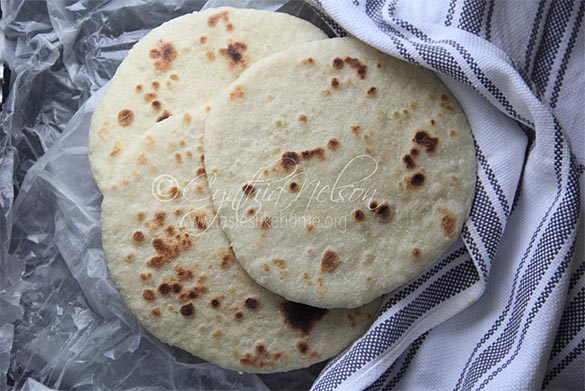 At the beginning of the month, I shared with you a Sri Lankan side dish – Pol (Coconut) Sambol, and what I’d promised then was to try their Pol (Coconut) Roti that I discovered in my research, and share with you. Well since that time, I have made Coconut roti twice, once with a slight adaptation of the original recipe, and the other time, I made it the way I’d like to have a Coconut Roti.
At the beginning of the month, I shared with you a Sri Lankan side dish – Pol (Coconut) Sambol, and what I’d promised then was to try their Pol (Coconut) Roti that I discovered in my research, and share with you. Well since that time, I have made Coconut roti twice, once with a slight adaptation of the original recipe, and the other time, I made it the way I’d like to have a Coconut Roti.
According to Dini, who is Sri Lankan and the recipe developer of The Flavor Bender, Coconut Roti is a popular type of flatbread in Sri Lanka that can be eaten for breakfast, lunch, dinner or even as a snack. An authentic version of the Coconut Roti requires no leavening agent, the roti is made with all-purpose flour, fresh grated coconut (obviously), finely chopped onions (shallots or red onions), green chilies and salt to taste. The ingredients are brought together as a dough with coconut milk or water or a combination of both. It is one of those roti(s) that is good on its own but can be served with accompaniments such as Coconut sambol, pulpy thick dhal, a variety of vegetarian curries, even meat curries. Of course, simply slathered with butter, it is a special treat.

There are certain things when I set out to make them, I make them exactly as the recipe states and others (which is more often the case), I make to suit my taste based on what I want to eat them with and how I want to eat them. With the first set of coconut roti, I had as my accompaniments, curried chicken, and coconut sambol. As a result, I opted for a simpler version of coconut roti, sans onions and green chilies.
This first making of the roti turned out exactly as the recipe said it would, soft while hot and warm, a little thick and easily torn. It tasted good on its own. I ate it first as is, then with butter and for a fuller meal, as I said above, with curried chicken and coconut sambol. It was like a thin sada roti. I didn’t get any distinct coconut flavour; it was more about knowing that there was coconut in the roti. On the following days, I enjoyed what was leftover on its own with tea. I found the lack of leavening agent made it a little dense though. I already knew that I was going to make the roti again, but this time, I would add baking powder and make it as we would, Sada roti.
Every family has their own way of making Sada roti and I am mainly referring here to the thickness of the roti. Some people’s Sada roti is larger, thinner, and rather pliable, while others are smaller (5 – 6 inches) and thicker with a soft inside, or large (7 – 8 inches) and thick with a soft inside. I like them all, but the one I grew up eating the most was the smaller, thick Sada roti. That was my mother’s preference but when she was feeling lazy, she made the larger ones (lol). I like the thick Sada roti because they are easy to cut open and generously spread butter on the warm insides, the butter melting into the roti. So, so very delicious and satisfying.
My second time making the Coconut Roti, I added baking powder to the mixture and when it was time to cut the dough and roll the roti, I made thick, round, soft Coconut Sada roti that
actually came out looking like pot bakes because I didn’t ‘saykay’ the roti edges – char the edges a little by letting the flames lick the sides of the roti as I rotated it. Oh well.
As I cooked this version of the roti, it swelled and puffed up nicely. It was soft on the inside with crisp brown parts on the outside. It begged for butter and baigan choka. The following days, the leftovers remained soft on the inside when reheated, and crisp and toasty on the outside. I re-heated on a tawa with a domed pot cover and then on another occasion in a cast iron skillet with a domed pot cover. I mentioned the domed pot cover simply because covering it with room at the top helped the heat circulate evenly, heating it up faster, but you can totally do this without a cover. Reheat the roti as you normally would.
Definitely give the recipe a try. I am giving you the Sri Lankan version and the one that I made like Sada roti.
Cynthia
cynthia@tasteslikehome.org
Sri Lankan Pol (Coconut) Roti
Yield: 8
INGREDIENTS
• 3 cups all-purpose flour
• 1½ cups fresh grated coconut
• 1 heaped teaspoon fine table salt
• Heaped half cup finely chopped red onions
• 3 – 4 finely minced long green chilies (see note
below)
• Water or fresh coconut milk for making dough
• Vegetable oil
DIRECTIONS
1. Mix together the flour and the salt then add the onions and chilies and mix to disperse evenly.
2. Add water or coconut milk a little at a time to bring the ingredients together to form a dough; when the dough comes together, knead for 3 minutes. Rub the dough with a little vegetable oil, cover and leave to rest for 1 hour (or at least 30 minutes). The dough can rest for as long as 4 hours.
3. Divide the dough into 8 equal pieces and form into balls.
4. Heat a tawa or pan over medium heat
5. Working with 1 piece of dough at a time, roll it into a 5-inch circle. Transfer to tawa/pan and cook for 2 – 3 minutes on each side. Let rest on a cooling rack or in a bowl lined with a tea towel. Repeat until all the roti are cooked.
NOTES
• In place of green chilies, use any green hot pepper or if you can’t find any, use any hot peppers you can.
• You can make fewer, thicker roti – cut the dough into 4, roll into a 6-inch circle and cook on each side for 4 minutes on low heat
Coconut Sada Roti
Use your regular sada roti recipe complete with baking powder etc, and add freshly grated coconut to the mixture, knead dough with water or fresh coconut milk.
Let the dough rest for at least 30 minutes (try for an hour), cut dough, form balls, and roll to desired thickness and cook as you normally would — large or small, thick, or thin.
If using 3 cups flour, use 1½ cups grated coconut
If using 4 cups flour, use 2 cups grated coconut
Whatever amount of flour you are using, use half that amount of fresh grated coconut.










